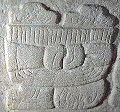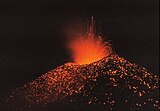Portal:Central America
The Central America Portal

Central America is a subregion of North America. Its political boundaries are defined as bordering Mexico to the north, Colombia to the south, the Caribbean Sea to the east, and the Pacific Ocean to the west. Central America is usually defined as consisting of seven countries: Belize, Costa Rica, El Salvador, Guatemala, Honduras, Nicaragua, and Panama. Within Central America is the Mesoamerican biodiversity hotspot, which extends from northern Guatemala to central Panama. Due to the presence of several active geologic faults and the Central America Volcanic Arc, there is a high amount of seismic activity in the region, such as volcanic eruptions and earthquakes, which has resulted in death, injury, and property damage.
In the pre-Columbian era, Central America was inhabited by the Indigenous peoples of Mesoamerica to the north and west and the Isthmo-Colombian peoples to the south and east. Following the Spanish expedition of Christopher Columbus' voyages to the Americas, Spain began to colonize the Americas. From 1609 to 1821, the majority of Central American territories (except for what would become Belize and Panama, and including the modern Mexican state of Chiapas) were governed by the viceroyalty of New Spain from Mexico City as the Captaincy General of Guatemala. On 24 August 1821, Spanish Viceroy Juan de O'Donojú signed the Treaty of Córdoba, which established New Spain's independence from Spain. On 15 September 1821, the Act of Independence of Central America was enacted to announce Central America's separation from the Spanish Empire and provide for the establishment of a new Central American state. Some of New Spain's provinces in the Central American region (i.e. what would become Guatemala, Honduras, El Salvador, Nicaragua and Costa Rica) were annexed to the First Mexican Empire; however in 1823 they seceded from Mexico to form the Federal Republic of Central America until 1838. (Full article...)
Selected article

The Spanish American wars of independence (Spanish: Guerras de independencia hispanoamericanas) took place throughout Spanish America during the early 19th century, with the aim of political independence from Spanish rule. Struggles for sovereignty in both hemispheres began shortly after the outbreak of the Peninsular War as a front in the larger Napoleonic Wars, between royalists who favored a unitary monarchy, and patriots who favored either plural monarchies or republics. Thus, the strict period of military campaigns would go from the Battle of Chacaltaya (1809), in present-day Bolivia, to the Battle of Tampico (1829) in Mexico.
In 1808, the abduction of the Spanish royal family by Napoleon Bonaparte, the Abdications of Bayonne, gave rise two years later to an emergence of liberalism and desire for liberties throughout the Spanish Empire. At first, some major cities or capitals formed local Juntas on the basis of laws from the Hispanic tradition. The violent conflicts started in 1809, with short-lived juntas established to govern in Chuquisaca, La Paz and Quito opposing the government of the Supreme Central Junta of Seville. At the beginning of 1810, new juntas appeared across Spanish America when the Central Junta fell to the French invasion. Although various regions objected to many crown policies, "there was little interest in outright independence; indeed there was widespread support for the Spanish Central Junta formed to lead the resistance against the French". While some Spanish Americans believed that independence was necessary, most who initially supported the creation of the new governments saw them as a means to preserve the region's autonomy from the French. Although there had been research on the idea of a separate Spanish American ("creole") identity separate from that of Iberia, political independence was not initially the aim of most Spanish Americans, nor was it necessarily inevitable. (Full article...)Did you know...
- ... that Mariano Fiallos Oyanguren refused to participate in an attempt to rig the 1990 Nicaraguan presidential election?
- ... that Marita Camacho Quirós, who was First Lady of Costa Rica (1962–1966), is the oldest former first lady in the world and a supercentenarian?
- ... that José Adán Aguerri's family opened the first movie theater in Nicaragua?
- ... that peasant leader Medardo Mairena was the sixth aspiring presidential candidate in the 2021 Nicaraguan general election to be arrested?
- ... that Panama cross-banded tree frog males synchronize their mating calls to confuse predators that locate them by sound?
- ... that the 7th Macho de Monte Infantry Company of the Panama Defense Forces was named after a tapir?
- ... that goalkeeper Daniela Solera had the most touches of any Costa Rican player in their opening match of the 2023 World Cup?
- ... that the Central American government voted for annexation to the First Mexican Empire after a request from Regent Agustín de Iturbide?
Related portals
Get involved
For editor resources and to collaborate with other editors on improving Wikipedia's Central America-related articles, see WikiProject Central America.
Need help?
Do you have a question about Central America that you can't find the answer to?
Consider asking it at the Wikipedia reference desk.
General images
In the news
- 15 May 2024 – Nicaragua–United States relations
- The United States impose visa restrictions on more than 250 members of the Nicaraguan government and also sanction three Nicaraguan entities for "repressive action" and a failure to control migrant smuggling through Nicaragua. (Reuters)
- 5 May 2024 – 2024 Panamanian general election
- Panamanians elect their President and members of the National Assembly. (Reuters)
- José Raúl Mulino, the stand-in for former president Ricardo Martinelli, wins the presidential election with more than 35% of the vote, after his three nearest opponents conceded. He will assume office in July. (AP)
- 3 May 2024 –
- Panama bans First Quantum Minerals from extracting copper following the closure of its Cobre Panamá mine last year. (Reuters) (The Globe and Mail)
- 30 April 2024 –
- The International Court of Justice rejects a request by Nicaragua asking the court to order Germany to suspend aid to Israel. (euronews)
- 6 April 2024 – 2024 raid on the Mexican embassy in Ecuador
- Nicaragua suspends diplomatic relations with Ecuador following the raid on the Mexican embassy in Quito, Ecuador. (Al Arabiya)
Subcategories
Topics
Associated Wikimedia
The following Wikimedia Foundation sister projects provide more on this subject:
-
Commons
Free media repository -
Wikibooks
Free textbooks and manuals -
Wikidata
Free knowledge base -
Wikinews
Free-content news -
Wikiquote
Collection of quotations -
Wikisource
Free-content library -
Wikiversity
Free learning tools -
Wiktionary
Dictionary and thesaurus










![Image 10Mesoamerica and its cultural areas[according to whom?] (from Mesoamerica)](http://upload.wikimedia.org/wikipedia/commons/thumb/7/79/Mesoamerica_english.PNG/120px-Mesoamerica_english.PNG)









![Image 21Mesoamerica and Central America in the 16th century before Spanish arrival [according to whom?] (from Mesoamerica)](http://upload.wikimedia.org/wikipedia/commons/thumb/0/06/Mesoam%C3%A9rica_y_Centroamerica_prehispanica_siglo_XVI.svg/120px-Mesoam%C3%A9rica_y_Centroamerica_prehispanica_siglo_XVI.svg.png)













































